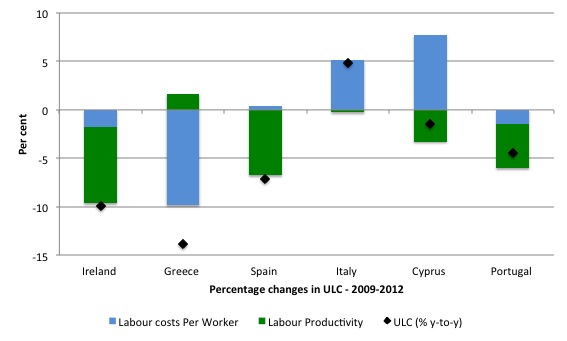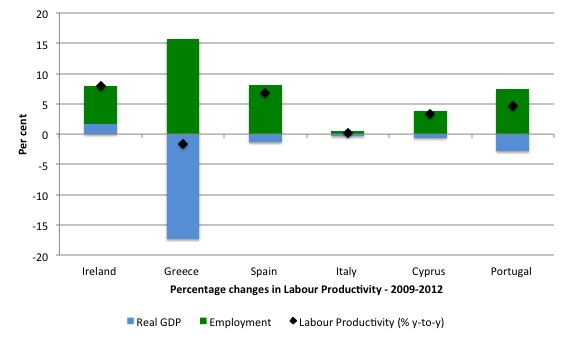The reason I ask that question is because I read in the UK Guardian article…
Eurozone nowhere near creating a truly federal structure
I have been trawling through the AMECO database for part of today as a means to learn more about what is happening in Europe as austerity continues into its fourth year for most nations. One of the neo-liberal mantras has been that the enduring crisis has been the result of major imbalances in current accounts (trade in goods and services and associated income flows) between the European nations. This reasoning implicates excessive wages growth in highly regulated labour markets, which also undermines the incentives for productivity growth (hence competitiveness declines and export markets shrink and imports become attractive). Alleged fiscal laxity is also implicated – excessive public employment growth, which apparently is less productive and encourages excess wages growth (stronger trade unions, better job protection). Taken together these claims are made about the peripheral Euro nations, which are in such trouble at present. This discussion has underpinned the policy push for austerity and largely denies the alternative view (which I largely adhere to) that the monetary union was ill conceived from day one and its design was incapable of resisting the major negative aggregate demand shock that arose in 2008. There was no federal fiscal capacity and no uniform banking rules. Any way, I am looking into some of the components of the first story – and examining what has been happening to unit labour costs. This blog reports the early stages of that work.
It is now commonplace to ask the following question when responding to the neo-liberal claims that the Euro crisis is about imbalances in current accounts and competitiveness has to be restored via austerity – attacking wages and conditions and increasing labour productivity.
In the words of Dani Rodrik in his September 2013 presentation – The Euro Crisis, Portugal, and Europe’s Future:
What is Florida’s current account deficit?
Substitute any state/territory/province in your favourite federal system where the national government has currency sovereignty and the following will apply.
As Rodrik says:
We don’t know … because we don’t care … [because] … Florida is not a relevant economic unit …
That is, in terms of the capacity of a sovereign (currency-issuing) nation to resolve any asymmetric aggregate demand shocks within its currency borders.
Functioning federal systems have free trade across state boundaries, uniform national banking rules, a central bank that acts as the defender of financial stability (lender of last resort to all banks within the federation), national government fiscal transfers across state boundaries on the basis of national priorities (to maintain growth in output and employment at high levels), unimpeded internal labour migration.
Within this type of system, the federal entity – the currency-issuer – has to be able to spend freely and issue debt to match that net spending if there are voluntary rules in place to prevent the central bank from directly “funding” the treasury operations at the federal level.
The central bank and the treasury – the two parts of the consolidated government sector – have to work together to ensure that the treasury operations are executed without disruption to financial system. That is, the central bank credits private bank accounts according to the spending desires of the treasury.
That preferred option is that the federal government does not issue debt to the private sector. But it is largely immaterial whether it does so or not for the purposes of maintaining viability of the sub-federal units (such as Florida in the US).
Overlaying that should be the requirement that fiscal and monetary policy ultimately be ratified on a regular basis by the people via elections. One of the reasons I am not scared of fiscal policy being used freely (without fiscal rules) is that a government that abuses its mandate can be thrown out at the next election. I am not denying that it can cause damage in the interim but if electoral cycles are relatively short then the damage is limited.
There also should not be unelected and unaccountable bodies being given responsibility for the design or implementation of macroeconomic policy. This is the trend everywhere as the neo-liberals seek to vest these powers and responsibilities in bodies that are stacked with ideologues of the same persuasion. They want to limit the elected government because they know that the policies that they advocated – self-regulating markets – ultimately increase unemployment and poverty – a recipe for disaster for the elites in a democratic state.
While federal systems usually create a constitutional split in spending and taxation powers between the federal and sub-federal levels, which means that the member states have some autonomy, there is now question that the federal government always stands ready to provide funds to the states in times of crisis and instigate spatially targetted fiscal stimulus if a particular state or region is in trouble.
The flexibility of this system as in the US and Australia is that the Federal Government always has the capacity to defend the overall economy in times of major aggregate demand failure. Whether they issue federal debt to the private markets or instruct the central bank to purchase their debt is irrelevant in this case.
The bond markets understand that such a government is risk-free because it issues its own currency and if worse comes to worse (say, its tax base collapses) it will always change regulations to make that currency-issuing capacity transparent. That is, the central bank will always ensure the government is solvent in its own currency.
So states within a federal system give up some sovereignty – but that is clearly defined in the sharing of responsibilities. They also do so because they are units within one nation, with common purposes, shared cultural artifacts and the knowledge that the federal unit is working in the interests of all of the people.
The monetary union in Europe bears no similarity to such an effective-functioning federation and that is the main reason it is still in crisis.
Examining competitiveness
With that context in mind, I have been examining shifts in competitiveness since 2009 in Europe today. In the recent past (August 26) I examined this question using the Bank of International Settlement’s real effective exchange rate (REER) indexes.
I concluded that the Euro nations have not succeeded in significantly increasing their competitiveness despite massive cuts. Internal devaluation is not an effective way to increase international competitiveness. The costs of such a strategy are too high and society breaks down before you get close to the goal.
Please read my blog – Fiscal deficits in Europe help to support growth – for more discussion on this point.
In this blog, we approach the competitiveness issue using unit labour costs (ULCs) as the measure.
You will benefit from reading an excellent 2011 paper from my friend at the Asian Development Bank Jesus Felipe (and his colleague, Utsav Kumar) – Unit Labor Costs in the Eurozone: The Competitiveness Debate Again. This paper provides a very readable account of the difficulties of using and interpreting ULCs measures at the aggregate level.
The following analysis uses the – AMECO Annual Macroeconomics Database – supplied by the European Commission. It is an excellent database for this type of analysis.
Unit labour costs are defined as the labour cost per unit of output produced and is the ratio of total labour costs (in nominal terms) divided by total GDP (in real terms).
So:
ULC = TLC/Y
where TLC is total labour costs and Y is real GDP.
We can re-arrange that by expressing both the numerator and denominator in per employed person terms to derive:
ULC = (TLC/EMP)/(Y/EMP)
where EMP is total employment and (TLC/EMP) is the total labour compensation per employed person and (Y/EMP) is real output per employed person, or labour productivity. This is a useful way of expressing the ULCs measure as we will see.
If we summarise (TCL/EMP) as LC and (Y/EMP) as LP then:
ULC = LC/LP
which in English is just unit labour costs equals total labour costs per employed person divided by labour productivity.
We can express this in terms of changes rather than levels (using some calculus) and we would get a familiar decomposition of the change in ULCs as:
∆ULC = ∆LC – ∆LP = ∆LABOUR COSTS – ∆OUTPUT + ∆EMPLOYMENT
The Greek Delta (∆) is used to denote change and the change in LP is the difference between the change in real output and the change in employment. The ∆ in this case refers to annual percentage changes.
This decomposition formula allows us to trace the sources of change in ULCs.
For example, ULCs will rise if labour costs grow faster than labour productivity and vice-versa.
Of interest, is that ULCs can fall if the decline in employment is faster than the decline in output (so LP rises) even if labour costs are unchanged. So austerity drive improvements in competitiveness by massive employment cuts. The macroeconomic losses (lost income) of the resulting unemployment are massive and such a strategy is deeply flawed.
It is much better to reduce ULCs by stimulating overall growth and ensuring the growing employed labour force is working better.
The following graphs show the decomposition of ULCs between 2009 and 2012 for all the peripheral Eurozone nations.
Note that the numbers will not conform to an exact accounting rule (as per the above formula) because the data used is not strictly additive according to the formula definitions (given the formula shown above is an approximation of percentage changes). But near enough is good enough for a quick blog and the conclusions are not dependent on this issue.
The data used is:
- The LCs measure is Nominal compensation per employee: total economy (AMECO series HWCDW)
- Real GDP is Gross domestic product at 2005 market prices (AMECO series OVGD)
- The ULCs measure is Nominal unit labour costs: total economy (Ratio of compensation per employee to real GDP per person employed.) (Ameco series PLCD)
- Labour Productivity is the difference between the real GDP growth and employment growth
The first graph shows the decomposition of ULCs in terms of numerator (wage costs) and denominator (labour productivity).
ULCs have fallen in all the nations shown other than Italy. The reduction in Ireland, Spain and Portugal has largely been driven by productivity increases. For Greece, it is the attack on workers wages and payments that has driven the fall in ULCs.
What has driven the labour productivity changes? Are they virtuous changes?
The next graph decomposes the change in labour productivity into its requisite parts – growth in output and employment. Labour costs per worker are in positive terms because they add to ULCs, whereas I have expressed labour productivity in negative terms because improvements reduce ULCs and vice versa. The green bars thus are negative if LP has been positive and positive if LP has been negative.
Accordingly:
∆LP = ∆OUTPUT – ∆EMPLOYMENT
So I have expressed employment in negative terms given growth (for a given output growth) reduces labour productivity. The green bars thus are negative if employment growth has been positive and positive if employment growth has been negative.
You can see that in all the nations shown, it is mass reductions in labour input that is responsible. For Greece, the massive decline in real GDP has just outstripped the shedding of jobs to generate a small fall in labour productivity overall.
I haven’t time today to decompose these movements by sector – public and private – or make some other adjustments.
But Dani Rodrik concludes that competitiveness has not been restored in the peripheral Euro nations and any “improvement” in ULCS are “overwhelmingly due to public sector” where “wages and employment cuts” have exceeded the output losses.
Conclusion
The massive macroeconomic losses and resulting increases in poverty rates, suicide rates and destruction of opportunities for the youth in these nations have delivered very little improvement in competitiveness when measured in terms of ULCs.
Certainly, the loss of competitiveness in the period leading up to the crisis by these nations has barely been scratched by the austerity drive.
Chasing minute gains relative to massive losses is a very ill-conceived economic policy strategy. And that lack of responsible policy management has to be seen in the context of a singular failure to make any significant progress towards rendering the question – what is Greece’s current account balance? – irrelevant.
The big need was to create a truly federal structure in the Eurozone. They are no where near that and that means the next crisis is just around the corner.
Meanwhile – across the Channel – Growth is occurring
It seems that in the face of austerity there is some form of growth occurring in the UK at least – if the Prime Minister’s cranial region is anything to go by – (see Story).
That is enough for today!
(c) Copyright 2013 Bill Mitchell. All Rights Reserved.



Hi Bill, shouldn’t the below sentence say “…by productivity increase”?
ULCs have fallen in all the nations shown other than Italy. The reduction in Ireland, Spain and Portugal has largely been driven by productivity decline.
The US lets towns and cities go bankrupt. I think soon we will see it let states go bankrupt as well. So the US is no model for a functioning fedaration, IMO.
Dear Matthias (at 2013/09/19 at 1:15)
Yes. Thanks for picking up the typo. I have fixed it now.
I appreciate your scrutiny.
best wishes
bill
Amendment II
Posted on Billy Blog-Australia
The Buffer Stock Employment Model [hereafter BSE] is brilliant-it is also so obvious as a solution to ubiquitous unemployment [and particularly pervasive in the OECD], it is a puzzlement why it has not invited more studies of the myths and sacred cows which stand in the way of its implementation. The most pronounced myth/sacred cow, of course, being the belief: The market can provide anyone wanting a job, with a job. This hasn’t been true since the mid-1970’s-and the progression of automation, globalization, etc., as we advance into the 21st Century, makes the market less and less viable as a source of jobs. Our “leaders” celebrate the advances of automation in the marketplace, and then get a “deer in the headlights” regarding the displaced employee.
In the U.S., we have a version of the BSE, as well…Public Law 15 USC § 3101, which “Authorizes” the creation of a “reservoir of public employees” anytime our unemployment rate exceeds “3%” [see HR 870 for deficit-neutral implementation]-In short, there is no time in which our unemployment rate in America should exceed 3%…
So why do we have 12 million jobless Americans, a 7.3% unemployment rate, and the CBO projecting that it will be 2017 for us to get back to even an anemic 5.5%, with unemployment benefits long since expired; and if the market fails, the unemployed are out of luck?
Further, BSE/15 USC § 3101 is a Pro-Market solution….the market thrives when we have a robust, employed, consuming workforce….and least understood, but for Social Security Insurance moneys percolating up through our economy, in the meltdown, we would be buried in another Great Depression!
And proposed here, like Social Security Insurance, The Neighbor-To-Neighbor Job Creation Act is a deficit-neutral, federally mandated Social Insurance, owned by our employed, to hire/train our unemployed. For a modest 4% of salary policy cost we can create more “private-sector” jobs in 6 months, than our current path [HR 2847], in 6 years.
In short, an expanding and contracting public workforce [BSE/15 USC § 3101] is an INDISPENSABLE component to the effective functioning of a modern market economy, i.e., the market going forward in the 21st Century.
The unemployed win, and capitalism wins…..
See: FULL EMPLOYMENT IS A PRO-MARKET CONCEPT, on Amazon/Kindle
Jim Green, Democrat opponent to Lamar Smith, Congress, 2000
CC: President Obama’s Council of Economic Advisers